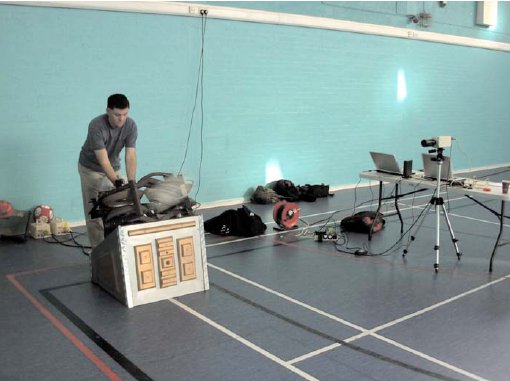
Eric Goff testing ball trajectories
By Matin Durrani
Qualification for next summer’s football World Cup in South Africa reaches its climax tomorrow — highlights include France’s return play-off with Ireland and Egypt squaring off against arch-rivals Algeria on the same day.
But some teams, like England, have already secured their passage to the world’s greatest sports tournament and will no doubt be already be dreaming of lifting the famous trophy.
England’s players have a night off tomorrow but if star midfielder David Beckham is feeling a bit bored, he might want to read a new paper in the American Journal of Physics by John Eric Goff of Lynchburg College, Virginia, and Matt Carré of the University of Sheffield in the UK.
Goff and Carré carried out a series of experiments in which soccer balls were launched from a machine while two high-speed cameras recorded portions of their trajectory. The equipment allowed the researchers to vary the balls’ launch speed and spin — balls could be fired either with no spin, topspin, backspin, sidespin or any combination.
From the resulting data, the two physicists then calculated the “lift” drag coefficient on the ball and the “sideways” drag coefficient, CS. If the ball has pure topspin or pure backspin then CS is zero, but if the ball has any other spin, the value of CS is not zero.
All lovely stuff, of course, but where does Beckham come in? Well, Goff and Carré then examined Beckham’s famous 90th-minute free kick taken against Greece in October 2001 that secured England’s qualification for the 2002 World Cup in France. His carefully taken kick bent around the wall before landing plum in the back of the Greek net and secured England a dramatic last-minute equalizer in the 2–2 draw.
Using TV footage of the famous match, the two physicists calculated that the ball left Beckham’s foot at a speed of 36 m/s at which point its “Reynolds number” (air speed times ball diameter, divided by kinematic viscosity) was of 5.1 x 10^5^. The ball had an average rotational velocity of 63 radians per second, rose above the height of the crossbar during the flight and moved about 3 m sideways, before slowing down to about 19 m/s as it dipped into the corner of the goal.
Goff and Carré then did a back-of-the-envelope calculation to estimate a value for CS, which was found to be about 0.2 for the famous shot.
And the punchline? Sorry folks, there isn’t one. But maybe the paper will persuade Becks, who’s currently on loan from LA Galaxy at AC Milan, to swot up on a bit of simple physics before next summer’s tournament. Assuming he makes the team, that is.


